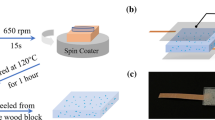Abstract
A flexible capacitive tactile sensor with adjustable characteristics, i.e., measurement range and sensitivity, has been developed. The proposed sensor is designed for large pressure measurement; therefore, polydimethylsiloxane (PDMS) material is selected as the material of the dielectric layer between the parallel plate electrodes of the sensor. Since the elasticity of the PDMS material can be adjusted by the mixing ratio of PDMS pre-polymer and curing agent during formation, sensors in different measurement ranges, i.e., 240–1,000 and 400–3,000 kPa, and corresponding sensitivities, i.e., 2.24 and 0.28 %/MPa, were respectively constructed and demonstrated. These measurement ranges are suitable for most of the biomechanical applications, especially for plantar pressure measurement. Moreover, because the output of the sensor, i.e., capacitance, is highly influenced by the dimension of the sensor structure, each sensor consists of four independent capacitance elements. The output of each sensor is averaged by four capacitances for single force measurement. This could improve the measurement accuracy in practical situation. Also, linearity of the measurement response could be enhanced and it was shown by the R-squared values in two measurement ranges, i.e., 0.9751 and 0.9881, respectively. The proposed sensor is flexible and miniaturized and has the potential to be applied to biomechanical applications.









Similar content being viewed by others
References
Akbar M, Shanblatt MA (1992) Temperature compensation of piezoresistive pressure sensors. Sensors Actuators A Phys 33:155–162
Akbar M, Shanblatt MA (1993) A fully integrated temperature compensation technique for piezoresistive pressure sensors. IEEE Trans Instrum Meas 42:771–775
Bamberg SJM, Benbasat AY, Scarborough DM, Krebs DE, Paradiso JA (2008) Gait analysis using a shoe-integrated wireless sensor system. IEEE Trans Inf Technol Biomed 12:413–423
Caselli A, Pham H, Giurini JM, Armstrong DG, Veves A (2002) The forefoot-to-rearfoot plantar pressure ratio is increased in severe diabetic neuropathy and can predict foot ulceration. Diabetes Care 25:1066–1071
Chelius G, Braillon C, Pasquier M, Horvais N, Gibollet RP, Espiau B, Coste CA (2011) A wearable sensor network for gait analysis: a six-day experiment of running through the desert. IEEE Trans Mechatron 16:878–883
Cheng MY, Huang XH, Ma CW, Yang YJ (2009) A flexible capacitive tactile sensing array with floating electrodes. J Micromech Microeng 19:115001
Cheng MY, Lin CL, Lai YT, Wang YJ (2010) A polymer-based capacitive sensing array for normal and shear force measurement. Sensors 10:10211–10225
Chiang CC, Lin CCK, Ju MS (2007) An implantable capacitive pressure sensor for biomedical applications. Sens Actuators A Phys 134:382–388
Chow WWY, Lei KF, Shi G, Li WJ, Huang Q (2006) Microfluidic channel fabrication by PDMS-interface bonding. Smart Mater Struct 15:S112–S116
Deluzio KJ, Astephen JL (2007) Biomechanical features of gait waveform data associated with knee osteoarthritis: an application of principal component analysis. Gait Posture 25:86–93
Goldie PA, Matyas TA (1996) Deficit and change in gait velocity during rehabilitation after stroke. Arch Phys Med Rehabil 77:1074–1082
Kim HK, Lee S, Yun KS (2011) Capacitive tactile sensor array for touch screen application. Sens Actuators A Phys 165:2–7
Lee YS, Wise KD (1982) A batch-fabricated silicon capacitive pressure transducer with low temperature sensitivity. IEEE Trans Electron Devices 29:42–48
Lee HK, Chang SI, Yoon E (2006) A flexible polymer tactile sensor: fabrication and modular expandability for large area deployment. J Microelectromech Syst 15(6):1681–1686
Lee HK, Chung J, Chang SI, Yoon E (2008) Normal and shear force measurement using a flexible polymer tactile sensor with embedded multiple capacitors. J Microelectromech Syst 17(4):934–942
Lei KF, Lee KF, Lee MY (2012) Development of a flexible PDMS capacitive pressure sensor for plantar pressure measurement. Microelectron Eng 99:1–5
Mizelle C, Rodgers M, Forrester L (2006) Bilateral foot center of pressure measures predict hemiparetic gait velocity. Gait Posture 24:356–363
Muhammad HB, Recchiuto C, Oddo CM, Beccai L, Anthony CJ, Adams MJ, Carrozza MC, Ward MCL (2011) A capacitive tactile sensor array for surface texture discrimination. Microelectron Eng 88:1811–1813
Peng P, Rajamani R, Erdman AG (2009) Flexible tactile sensor for tissue elasticity measurements. J Microelectromech Syst 18(6):1226–1233
Petropoulos A, Kaltsas G, Goustouridis D, Gogolides E (2009) A flexible capacitive device for pressure and tactile sensing. Proced Chem 1:867–870
Reid SM, Graham RB, Costigan PA (2010) Differentiation of young and older adult stair climbing gait using principal component analysis. Gait Posture 31:197–203
Urry S (1999) Plantar pressure-measurement sensors. Meas Sci Technol 10:R16
Acknowledgments
Authors would like to thank the Chang Gung University for the financial support (Project number: UERPD2A0101).
Author information
Authors and Affiliations
Corresponding author
Rights and permissions
About this article
Cite this article
Lei, K.F., Lee, KF. & Lee, MY. A flexible PDMS capacitive tactile sensor with adjustable measurement range for plantar pressure measurement. Microsyst Technol 20, 1351–1358 (2014). https://doi.org/10.1007/s00542-013-1918-5
Received:
Accepted:
Published:
Issue Date:
DOI: https://doi.org/10.1007/s00542-013-1918-5




